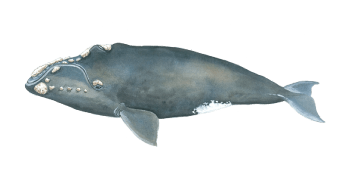
North Atlantic right whale
(Eubalaena glacialis)
The northern right whales were the first of the great whales to be hunted in commercial whaling. They were slow, rich in oil and baleen and easy to catch.
So they were considered the “right whales to hunt”. At the beginning of the 20th century, they were hunted almost to the point of extinction. There are three species to distinguish: North Atlantic Right Whale; North Pacific Right Whale (E. japonica) and Southern Hemisphere Right Whale (E. australis).
On a functional basis, the North Atlantic population is considered to be extinct since there are only about 300-400 individuals left. The species is significantly affected by mortalities from collisions with ships and entanglement in fishing gear.
General information
Further names: Portuguese: Baleia-basca
Size of adults: Females max. 18m; males about 1-1,5 m shorter than females
Prey: Feed exclusively on plankton feeders (mainly copepods)
Reproduction: Sexually mature with 9-10 years. Females often mate with more than one male in succession, their mating system is based on sperm competition. Male right whales have the largest testes in the animal kingdom (900 kg weight).
Life Span: up to 70 years
Behaviour: Right whales occasionally get curious and approach boats. They are slow swimmers that often show activity at the surface, often breaching and lobtailing. In nursing areas where they give birth, females are often observed turning on their back and embracing their newborn calfs with pectoral fins on their underside. They feed by skimming; moving through the water with their mouth agape and filtering prey through their finely meshed baleen plates.
Range: Northern Hemisphere; frequently sighted off the coasts of Nova Scotia (Eastern Canada) down to coasts of Florida and Georgia. They embark on seasonal migrations between tropical calving grounds and higher latitudes to designated feeding areas. In spring time, they assemble at Cape Cod and around Massachusetts bay.
Madeira: One registered sighting in the year 1964
Distinctive features: Large and rotund body with a black body base color with some white spots on underside. They have a relatively huge head with a strongly arched mouthline and very long baleen plates. Head and rostrum are covered with callosities, barnacles that are also known as “whale lice”, whose colonisation patterns are used for the identification of individual whales. They lack a dorsal fin and have paddle-shaped flippers. Their V-shaped spout can extend up to 5 m into the air and they tend to raise their flukes before diving.
Taxonomy: Mysticeti (Baleen whales); Familly: Balaenidae (Right whales; baleen whales without throat furrows)
Threats: Are reported as critically endangered by the IUCN and are listed among the world’s most critically endangered mammals with only about 300-400 animals left worldwide.
